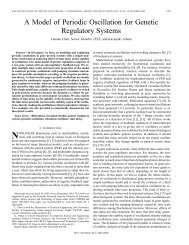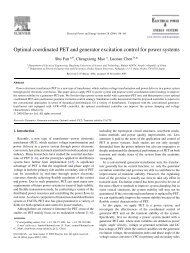Components of nodal prices for electric power systems - Power ...
Components of nodal prices for electric power systems - Power ...
Components of nodal prices for electric power systems - Power ...
Create successful ePaper yourself
Turn your PDF publications into a flip-book with our unique Google optimized e-Paper software.
42 IEEE TRANSACTIONS ON POWER SYSTEMS, VOL. 17, NO. 1, FEBRUARY 2002There<strong>for</strong>e, the operation problem <strong>of</strong> a <strong>power</strong> system <strong>for</strong>the given loads ( , ) can be <strong>for</strong>mulated as an OPF problem[8]–[10]Min <strong>for</strong> (1)s.t. (2)(3)whereandhave andequations, respectively, and are column vectors whilestands <strong>for</strong> the transpose <strong>of</strong> a vector .: scalar, short-term operating cost, such as fuelcost;: vector, equality constraints, such as bus<strong>power</strong> flow balances (Kirch<strong>of</strong>f’s laws);: vector, inequality constraints includinglimits <strong>of</strong> all variableswhereincludes all variable limits and functionlimits, such as upper and lower bounds <strong>of</strong> transmission lines,generation outputs, stability or security limits [10], etc. Whenis a fuel cost function <strong>of</strong> the system, can be expressed aswhere is the fuel cost <strong>of</strong>the th generator. Notice that can also be a benefit functionalthough this paper takes as a cost function.Obviously, (1)–(3) are a typical OPF problem as far as thedemands ( , ) are given. There are many efficient approacheswhich can be used to obtain an optimal solution, such assuccessive linear programming, successive quadratic programming,the Newton method, the – decomposition approach[6], [7], the surrogate constraint and functional trans<strong>for</strong>mationapproaches [8]–[10].B. Nodal PriceDefine the Lagrangian function (or system cost) <strong>of</strong> (1)–(3) as, thenwhereandare the Lagrangian multipliers (or dual variables) associatedto (2) and (3), respectively, and are usuallyexplained as shadow <strong>prices</strong> from the viewpoint <strong>of</strong> economics.Hence,and. Actually, the Lagrangianfunction can also be viewed as an equivalentsystem cost.Then at an optimal solution ( ) and <strong>for</strong> a set <strong>of</strong> given( , ), the <strong>nodal</strong> <strong>prices</strong> <strong>of</strong> real and reactive <strong>power</strong> <strong>for</strong> each busare expressed below <strong>for</strong>(4)(5)where and are <strong>nodal</strong> <strong>prices</strong> <strong>of</strong> real and reactive <strong>power</strong>at bus- , respectively. and are usuallyconsidered as the real and reactive <strong>power</strong> transaction chargesfrom bus- to bus- .Notice that the <strong>nodal</strong> <strong>prices</strong> derived by differentiating themaximized social welfare function with respect to the real andreactive demands, yield the same results as (5) and (6). That is,first replace (1) with “<strong>for</strong> ” subject to the same constraints as (2) and (3),whereis short-term value-added function <strong>of</strong> thecustomers connected to bus- . Then we can prove that <strong>nodal</strong><strong>prices</strong> are the same as (5) and (6), by letting the marginalbenefitequal to the <strong>nodal</strong> <strong>prices</strong> <strong>of</strong> realand reactive <strong>power</strong> at the optimal solution, respectively [5].There<strong>for</strong>e according to (5), the <strong>nodal</strong> price <strong>of</strong> real<strong>power</strong> at bus- can be viewed as the system marginal cost(the sum <strong>of</strong> a marginal generation cost plus a set<strong>of</strong> premiums corresponding to their respective constraints)created by an increment <strong>of</strong> real <strong>power</strong> load at bus- . Thesame explanation is also applicable to the <strong>nodal</strong> price <strong>of</strong>reactive <strong>power</strong> .A significant property <strong>for</strong> <strong>nodal</strong> <strong>prices</strong> is that each <strong>nodal</strong> priceis actually defined simply as a linear summation <strong>of</strong> all factorsaccording to (5) and (6) because each <strong>nodal</strong> price, e.g., canbe rewritten asThis property is completely different from that <strong>of</strong> AC <strong>power</strong>flow which is generally nonlinear to each source or route, andis also fundamental to the decomposition or coloring <strong>of</strong> <strong>nodal</strong><strong>prices</strong> in this paper. There<strong>for</strong>e, theoretically it is possible to tracethe contributions <strong>of</strong> all factors involving in the operations <strong>of</strong><strong>power</strong> <strong>systems</strong> to each <strong>nodal</strong> price.C. Problem and ExampleEquation (5) or (6) seems to have given a full description<strong>of</strong> each component <strong>for</strong> a <strong>nodal</strong> price even without any furtheranalysis. However, in contrary to intuitive observation, we willshow late that it is incorrect. Actually there are generally onlyone or two terms remaining nonzero at an optimal solution<strong>for</strong> (5) and (6) depending on the <strong>for</strong>mulation, even thoughmany constraints become active (or binding) and many generatorscontribute to this <strong>nodal</strong> price. The main reason is thatthe variables () in the Lagrangian function (4) [orOPF equations (1)–(3)] are all independent variables and only afew equations among (2) and (3) or have direct relation withcertain bus demand or . There<strong>for</strong>e, most <strong>of</strong> the terms in (5)or (6) are eliminated after differentiating with certain demandor , irrespective <strong>of</strong> any solution. We take a four-bus <strong>systems</strong>hown in Fig. 1 and Table I, as an example to show this point.(6)






